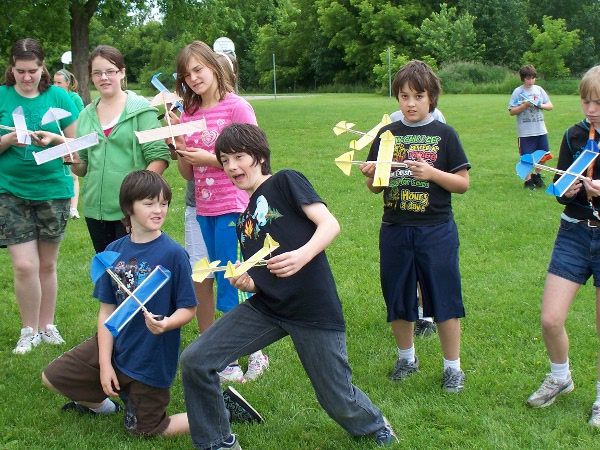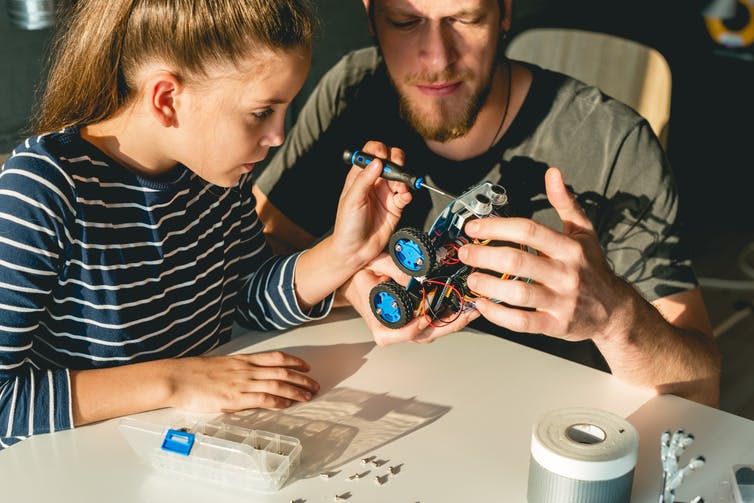Every child is a potential inventor. The desire to explore the world is genetically embedded in us. Breaking another toy, the kid is trying to understand how it is arranged, why the wheels are spinning and the lights are blinking. Properly organized technical creativity of children can satisfy this curiosity and include the younger generation in useful practical activities.
Definition
Creativity is a special type of activity during which a person departs from generally accepted patterns, experimentes and, as a result, creates a new product in the field of science, art, production, technology, etc. From a socio-economic point of view, only an object can be new did not exist before. From a psychological point of view, creativity is any process in which a person discovers something unknown to himself. The subjective significance of the invention comes to the fore when it comes to children.
Technical creativity is such an activity, the result of which is the creation of various technical objects (models, devices, all kinds of mechanisms). It is of particular importance when it comes to a developing industrial society.
Classification
There are several types of professional scientific and technical creativity. We list them:
- An invention that opens up an original way to solve a problem.
- Innovation, when a person improves a ready-made mechanism.
- Design, or creation of a device in accordance with the issued technical specifications.
- Design involving the construction of an object with certain functional as well as aesthetic characteristics.
A special place is given to constructive and technical activity, which is understood as the pre-professional creativity of children and youth. Unlike adult colleagues, they solve simple problems, rediscover already known methods of action. The main goal in this case is not the public benefit of the invention, but the development of research thinking and initiative among schoolchildren and students.
Children's technical creativity
Being an inventor is not easy. To create a new device, a person must have creative thinking. Focus on the final result and willingness to overcome the emerging technical difficulties are also needed. At the dawn of industrialization, it was believed that such qualities were inherent in birth by a small number of gifted engineers.
Today, teachers are sure: technical creativity can be taught to every person. But it is necessary to do this from a very young age so that the child gets used to think correctly, work rationally with information, and put into practice the knowledge learned in the lessons. It is imperative to arouse interest in technology. Therefore, children do not study complex physical phenomena, but create models of airplanes, cars, ships, spacecraft, robots, etc. that are understandable to them.
Tasks to be Solved
Technical creativity is a process during which:
- the child is preparing for future work;
- independence, activity, creative thinking, spatial imagination, criticality (the ability to evaluate the design features of devices) develop;
- interest in invention is forming;
- knowledge is acquired from the fields of physics, mathematics, computer science, etc .;
- industriousness, responsibility, determination, patience are brought up;
- the ability to work with drawings, scientific literature, as well as the skills of using measuring instruments, tools, special devices;
- self-esteem of the child is growing, pride for his work appears.
Emerging issues
In Soviet times, much attention was paid to the technical creativity of youth. The first sections of aircraft modeling appeared in the 20s of the XX century. Gradually, the range of activities expanded. Schoolchildren were involved in extracurricular activities, designed rockets and agricultural machines, electrical appliances and automation. Amateur circles acted everywhere. Clubs and stations of young technicians opened, exhibitions and competitions were held at which students received awards. Many designers and innovators attended such classes in childhood.

However, with the beginning of perestroika, most of the technical institutions have ceased to function. This was primarily due to the lack of funding. After all, technical creativity requires special equipment, the material base is becoming obsolete and is failing. Until now, many circles exist only thanks to the efforts of enthusiastic educators. The lack of modern equipment leads to a decrease in the quality of services. Meanwhile, demand for them remains stable. Today in the regions they are trying to solve this issue at the local level. Another problem is that technical creativity has ceased to be accessible to students from low-income families.
Organization Forms
Consider the ways in which today they are trying to introduce children to technical creativity. There are several of them:
- Technology lessons. They are held already in elementary school and provide for acquaintance with modeling, technology, and the manufacture of simple products.
- Mugs They can operate on the basis of schools or institutions of further education. Children attending the circle deeply study individual technical issues and are engaged in research.
- Olympics, exhibitions, contests. They allow students to demonstrate their achievements, draw attention to themselves, share their experiences with enthusiastic peers.
- Centers of children's technical creativity. As a rule, on their basis several sections function in different directions. Educational programs are designed for children of different ages. Conferences are regularly held at which students demonstrate their own projects and gain experience in public speaking.
Didactic requirements for circles and sections
The development of technical creativity of children will proceed successfully if the following conditions are met:
- The selected circle is interesting for the child, classes are held taking into account his preparation.
- Students understand why they acquire this or that knowledge and skills.
- The optimum ratio between the study of theoretical information and practical exercises is maintained.
- Material support meets modern requirements.
- The methods used are primarily aimed at developing students' independence, contribute to their creative self-realization.
- Systematically, children participate in shows or exhibitions, demonstrate their achievements, see results and their own progress.
Stages of technical creativity
In centers and circles, students' activities are built according to a certain algorithm. It includes 4 stages:
- Formulation of the problem. Children need to be included in the creative process, to create motivation for further work. At this stage, they are shown ready-made devices, videos, experiments, talk about the significance of the mechanism being studied, its practical application.
- Collection of information. You need to understand what knowledge students already have and what they have yet to get to know. For this, conversations, questionnaires, game forms (quizzes, crosswords, etc.) are used. Then the teacher voices the new information. Sometimes children themselves study literature, and then discussions, conferences, discussion of small reports are organized.
- Search for a solution. It is bad if children constantly make devices according to samples, doing mechanical copying. It is necessary to develop the design skills of students, to encourage their initiative, to learn to apply the knowledge gained creatively, to see various solutions to the problem.
- The implementation of the solution. It is important to choose the right objects for construction, so that children are able to make them on their own with minimal help from an adult.

The choice of teaching methods
Technical creativity is a process in which a person explores a problem and independently finds its solution. It is logical that when teaching this, the teacher constantly resorts to problem-search methods. Their essence lies in the fact that children are given a task whose algorithm of solution is unknown to them, and complete freedom of action is provided. It is allowed to peep something from other students, ask for help, make mistakes and redo the work several times.
No less difficult is the situation of choice for the child, when you can use several methods of action or means of designing crafts. In this case, you need to realize your desires, correctly assess the possibilities. Children have difficulty making independent decisions, and they need to be purposefully taught this.
Using active teaching methods does not mean that you can forget about the usual tables, stories and explanations, demonstration of films, experiments. All this is necessary when becoming acquainted with the material being studied.
The development of technical thinking
To activate students, special methods can be applied. For example, such:
- Brainstorm. A group of children put forward various hypotheses for solving the problem, including the most absurd. They only go to their analysis when a considerable number of assumptions are gathered.
- Sudden prohibitions. The ban on the use of certain mechanisms or parts allows you to abandon the usual patterns.
- New options. The teacher asks the children to come up with several solutions to the same problem.
- The method of absurdity. Students are given an impossible task (a vivid example is the invention of the perpetual motion machine).
Technical creativity is an activity that requires a person to have a broad outlook, developed imagination, independent thinking and interest in search activity. The prerequisites for it are laid in childhood, and parents and teachers should remember this if they want to grow highly qualified specialists.